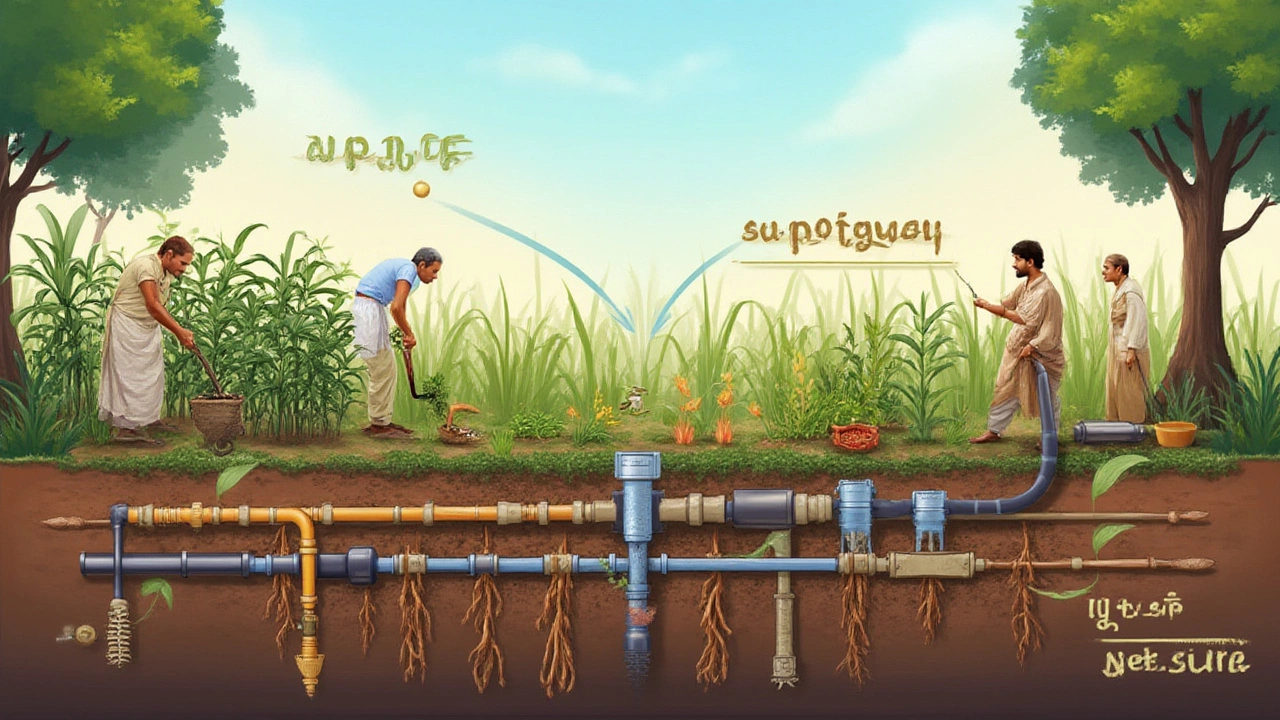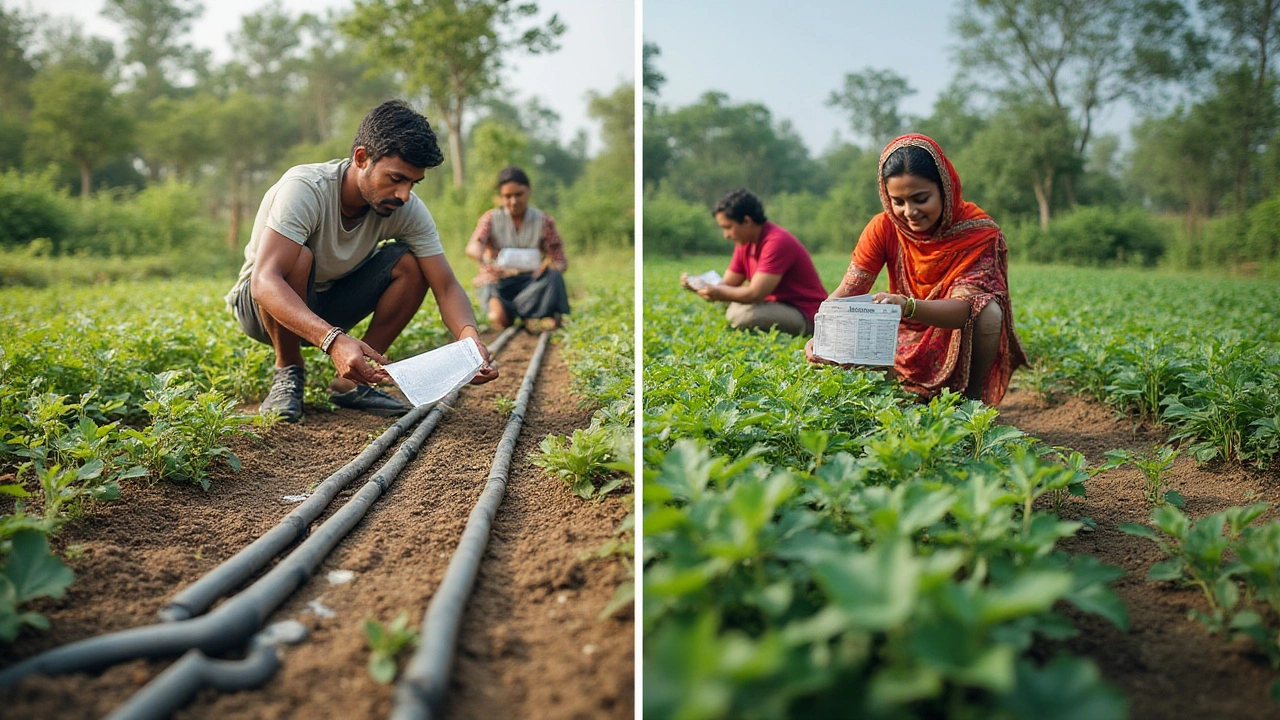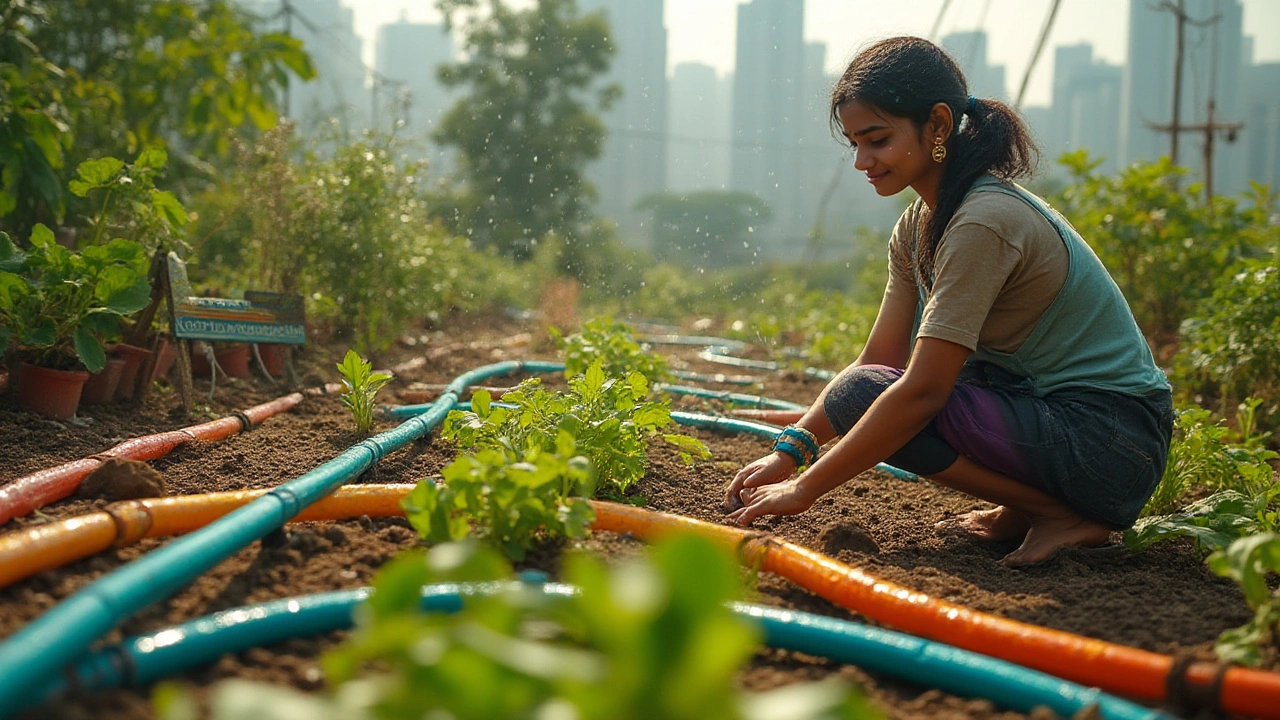Picture this: a tomato plant with leaves crisp from thirst next to another, glossy and green, roots happy below the soil’s surface. Both see the same sun, but one’s sitting pretty thanks to a secret network dripping water right at the root zone. That’s the magic of drip irrigation, a game-changer for small gardens and large fields alike. Folks are swapping sprinklers for tubes and emitters—because every drop of water is a paycheck for your plants, and nobody wants runaway bills or wilted veggies. If you’ve been scouring the shelves for irrigation gear or just heard your gardener neighbor babble about "emitters per meter," there’s a pretty sharp split in the drip world. Two main types: surface and subsurface. Let’s dig into how each works, why it’s different, and which one might win you a bumper crop—or finally defeat your brown-thumbed reputation. Oh, and if you think this stuff is just for farmers, don’t scroll away: balcony gardeners and backyard rookies are getting in on the action, saving on both water and weed-pulling.
How Surface Drip Irrigation Works and Where It Shines
Surface drip irrigation is pretty much what it sounds like. Imagine a network of slim plastic tubes strewn over your planting beds, fitted with tiny holes or emitters. These tubes slowly leak water directly onto the soil, right where each plant’s stem pokes from the ground. Simple, visible, and easy to check for hiccups. Every time you peer down at your garden and spot lines trailing along the rows, you’re looking at a classic surface drip setup in action.
Now, the main reason folks love this system is control. You can deliver water straight to the root zone—no need to soak the whole bed or garden path. Plants like tomatoes, peppers, lettuce, and herbs all thrive with surface drip. It’s almost like giving them a water bottle at arm’s length, never over-soaking or leaving things parched.
Let’s get real about efficiency. Sprinklers casually lose up to 50% of their output to evaporation and wind. Surface drip cuts that number drastically, slashing water use by up to 70% in some gardens. And if you’re savvy, you can tweak row spacing, emitter flow rates, and timing. No more mystery wet spots or bone-dry corners. Here’s the best part: most home installations don’t need anything fancier than a pressure regulator, a filter to keep out grit, a roll of drip tubing, and some emitters. Snap them together, poke holes where your plants need a drink, stake down the lines, and connect to your garden hose or a rain barrel.
But surface drip works best under two conditions: flat or gently sloped ground, and organic mulch covering the tubes. Why mulch? It slows evaporation, keeps the system cool, and stops sunlight from breaking down plastic tubing. Mulch also blocks weed seeds from germinating—since surface drip only wets narrow strips, unwanted greens go thirsty and give up the fight. That’s a win-win in hot, dry climates or places with frequent droughts. Plus, for folks growing in containers, trays, or raised beds, it’s the easiest way to automate watering during a vacation.
Now for a couple of sticking points. With all the tubing on top of the soil, you’ll need to be mindful when planting, pulling weeds, or stepping across rows. Drip lines can kink or shift if you aren’t careful. And rodents sometimes take a nibble, so spot checks are smart. If you live somewhere sandy or dusty, flush the system out with clean water now and then—the emitters can clog. But, compared to drag-around hoses or thirsty sprinklers, it’s a minor trade-off. Pro gardeners swear by surface drip to limit foliar diseases (since leaves stay dry) and to keep fungal issues at bay.
Here’s a quick reference table that sums up the surface drip perks and quirks:
| Feature | Surface Drip Irrigation |
|---|---|
| Install Location | On top of the soil, under or above mulch |
| Best For | Vegetable rows, flower beds, container plants |
| Water Savings | Up to 70% vs. conventional sprinklers |
| Maintenance | Monitor tubing, flush emitters, protect from rodents |
| Ease of Troubleshooting | High—everything visible |
| Soil Evaporation | Medium (lowered when mulched) |
| Weed Suppression | Higher than sprinklers |
| Common Problems | Tubing exposure, clogs from soil/dust |
Surface drip might not sound flashy, but if you like results you can see (and fix), it’s hard to go wrong. Mix up your emitter types to match different crops—think wider spacing for squash, closer for onions. Take photos of your layout for future reference, label your lines, and don’t be shy about experimenting. Plenty of home gardeners discover bumper tomato harvests with surface drip, mostly by trial, error, and stubborn optimism.

Subsurface Drip: Underground Precision for Gardens and Fields
Subsurface drip is where things start to feel futuristic. Instead of tubing snaking above the soil, the lines run underground—usually 6 to 12 inches deep. Emitters, engineered to resist clogging, slowly leak water right where the roots can grab every drop. You might not even see the system at work unless you dig around. The big hook here: soil acts like a giant wick, spreading moisture horizontally, but keeping the topsoil dry. This is gold for weed control, disease prevention, and stealth watering.
Got a commercial field, orchard, or vineyard? Subsurface drip is standard fare. But small-scale gardeners looking for "set it and forget it" tech are catching on, too. If you hate dragging hoses, tripping over tubing, or want a lawn/garden you can still play on, this method rocks. Since all the gear sits below ground, there’s no sun damage, freezing, or animal bites. And you won’t mess up your lines with your boots while harvesting strawberries.
Here’s the kicker: subsurface drip delivers spectacular water-use efficiency—sometimes up to 95%, especially in sandy or compacted soils where other methods waste gallons. Root zones stay perfectly moist, but the surface remains dry. Guess what? Most weed seeds just give up. Fungi, foliar blights, and mildew can’t get a foothold because plant tops aren’t getting splashed or constantly damp. Lawns irrigated this way never suffer those yellow, patchy sun-scorch marks from above-ground spray. You can mow, play, and picnic without a single tube in the way.
The technology has evolved. Modern subsurface systems use pressure-compensating emitters that keep water flowing evenly—even over long distances or tough terrain. Filters and careful system design keep roots from plugging up emitters. While installation is trickier (trenching takes time and planning), you rarely need to sweat maintenance after the first season. Occasionally, you’ll flush lines or check for leaks. System lifespan? Ten to 20 years is common, making it a real investment for serious gardeners.
- Install tubes at the right depth. Too shallow, roots might dry out; too deep, plants could get thirsty. Six to eight inches covers most vegetables and lawns. Fruit trees and vines may need lines a foot down.
- Spacing matters. Typical layouts range from 12 to 18 inches apart for gardens—pay attention to root spread and the soil’s ability to move water sideways. Clay soils need lines closer together, while sandy soils allow wider spacing.
- Plan for filtration. A good in-line filter stops soil and grit before it clogs the system. A flush valve at the end lets you clear debris at season’s end.
- Map it out. Before covering up your lines, snap a few photos, make a diagram, or lay string to mark where tubing runs. You will thank yourself next planting season when you’re digging holes and want to avoid slicing a line.
Maybe you’re thinking: okay, but am I handy enough for this? Truth is, subsurface drip requires more setup than surface drip. Renting a trencher or enlisting a couple of friends helps. Some companies even offer DIY kits mapped for home gardens—but commercial growers usually commission a designer. Either way, the payoff is big. Studies in California and Israel, leaders in water-stressed farming, found that deep-rooted crops like tomatoes, peppers, grapes, and cotton use 30% less water, get fewer pests, and often yield more thanks to consistent moisture.
Here’s a data snapshot for subsurface drip systems:
| Feature | Subsurface Drip Irrigation |
|---|---|
| Install Location | 6 to 12 inches below soil surface |
| Best For | Lawns, perennial gardens, orchards, fields, tricky slopes |
| Water Savings | Up to 95% efficiency reported |
| Maintenance | Occasional flushing, root intrusion checks |
| Ease of Troubleshooting | Lower—system out of sight |
| Weed Suppression | Excellent; soil surface stays mostly dry |
| Common Problems | Root intrusion, physical digging damage |
| Estimated Lifespan | 10+ years |
Tips for subsurface newbies: pair your system with a soil moisture monitor. You want roots moist, not soggy—a probe takes out the guesswork. If your garden changes every year, try temporary surface drip before you dig deep. And always, always flush lines at season’s end.

Choosing Between Surface and Subsurface Drip: Real-World Scenarios, Pros, and Cons
So which system should you choose? It really boils down to your site, your crops, and how much hands-on work you like. For starters, drip irrigation of any kind beats random sprinkling or hand-watering by a mile when you care about water bills and healthy roots. If you want an easy install and love to keep an eye on everything, surface drip is beginner-friendly—like the training wheels of efficient irrigation. Mulch makes it even better, and you’ll be able to tweak, tune, and repair things on the fly. Great for home veggie patches, flower beds, and even greenhouses where lines might get shifted often.
Subsurface drip, on the other hand, is your move if you need a "hidden" system—like a weed-free lawn, berry patch, or orchard. The upfront work and planning can be daunting, but you gain trouble-free years afterward. Perfect for perennials, fruit trees, or places where running hoses gets old fast. If you’re tackling slopes, awkward-shaped beds, or care about a spotless garden, subsurface is worth the sweat.
There are curveballs to watch for with both. Surface drip makes it easy to spot leaks or kinks, but you might battle critters or sunlight damage. Subsurface keeps lines safe from everything—except your own shovel during next year’s planting. Surface systems need more frequent checks; subsurface needs good design and annual flushing. If your soil’s got loads of clay, subsurface can oversaturate—with sand, water might move too quick sideways and leave gaps. In most climates, though, both systems will crush sprinkler waste and slash watering needs.
Let’s break down some scenarios:
- Small veggie patch or raised beds? Surface drip, hands down. Easy to move, cheap to set up, and simple to repair. Bonus points for mulch.
- Big flower garden, ever-changing layouts? Surface wins for tweak-ability. If it’s permanent, subsurface might pay off, but only if you’re willing to trench.
- Fruit orchards, lawns, or areas you mow/play on? Subsurface is king. Invisible, keeps water in the root zone, and fights surface weeds.
- Poor, thin, or rocky soils? You may need closer emitter spacing, whichever style you use—test before installing miles of tubing.
- Worried about water bills? Both systems pay off. Reports from urban and suburban homeowners rank subsurface drip as the top water-saver for landscapes, and community gardens report using half their usual water with surface drip.
If you want to DIY, grab a drip kit for surface installs—it’s basically plug-and-play. For subsurface, draw your bed, mark trees, map your lines, and think about your digging skills. Some gardeners do both: surface drip for annuals and containers, subsurface for lawns and perennials. There’s no law saying you need to pick just one.
Final tip? No matter what system, regular maintenance is your best friend. Flush lines, clean filters, and once per season, check for leaks. If you’re a gadget lover, tie your setup to a timer or even a smartphone sensor. More tech, less stress—and lush plants the neighbors will envy.





